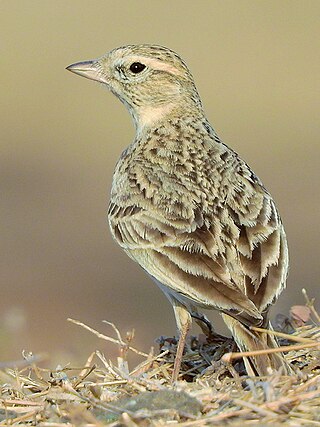
The greater short-toed lark is a small passerine bird. The current scientific name is from Ancient Greek. The genus name, Calandrella, is a diminutive of kalandros, the calandra lark, and brachydactila is from brakhus, "short", and daktulos, "toe".

The standard-winged nightjar is a nocturnal bird in the nightjar family.

The Tephritidae are one of two fly families referred to as fruit flies, the other family being the Drosophilidae. The family Tephritidae does not include the biological model organisms of the genus Drosophila, which is often called the "common fruit fly". Nearly 5,000 described species of tephritid fruit fly are categorized in almost 500 genera of the Tephritidae. Description, recategorization, and genetic analyses are constantly changing the taxonomy of this family. To distinguish them from the Drosophilidae, the Tephritidae are sometimes called peacock flies, in reference to their elaborate and colorful markings. The name comes from the Greek τεφρος, tephros, meaning "ash grey". They are found in all the biogeographic realms.

Cockroaches are insects belonging to the order Blattaria. About 30 cockroach species out of 4,600 are associated with human habitats. Some species are well-known as pests.

The Australian hobby, also known as the little falcon, is one of six Australian members of the family Falconidae. This predominantly diurnal bird of prey derives its name ‘longipennis’ from its long primary wing feathers. It occurs throughout Australia and other neighbouring countries with migrating individuals found on the islands of Indonesia and New Guinea.

Pruinescence, or pruinosity, is a "frosted" or dusty-looking coating on top of a surface. It may also be called a pruina, from the Latin word for hoarfrost. The adjectival form is pruinose.

The blue dasher is an insect of the skimmer family. It is the only species in the genus Pachydiplax. It is very common and widely distributed through North America and into the Bahamas.

The grey-rumped treeswift is a species of bird in the Hemiprocnidae family. Currently, four extant species are placed in the family. Like the other members of the Hemiprocnidae, this species is closely related to true swifts, but unlike true swifts, the treeswifts are arboreal in nature, often seen perched on trees and high-tension power transmission lines, and on pylons. When perched, the wing tips cross over the tail. This species is commonly found in peninsular Malaysia, but has an extremely large range with limited information about the population trend,.
Aglaothorax longipennis is a species of insect in family Tettigoniidae. It is endemic to the United States.

Aglaothorax is a genus of ovate shieldbacks in the family Tettigoniidae. There are about six described species in Aglaothorax.

Attopsis is an extinct genus of ants in the formicid subfamily Formicinae. While formerly containing a number of species, the genus is currently monotypic; the type species, Attopsis longipennis, is known from a single Early Miocene fossil found in what is now Croatia.
Plagiognathus longipennis is a species in the family Miridae, in the order Hemiptera . It is found in North America.

Dorypteryx is a genus of cave barklice in the family Psyllipsocidae. There are at least 4 described species in Dorypteryx.
Sphaeromias is a genus of biting midges in the family Ceratopogonidae. There are at least four described species in Sphaeromias.

Suillia longipennis is a species of fly in the family Heleomyzidae. It is found in North America.

Dolichopus longipennis is a species of long-legged fly in the family Dolichopodidae.
Amotus is a genus of broad-nosed weevils in the beetle family Curculionidae. There are at least three described species in Amotus.
Peritaxia is a genus of broad-nosed weevils in the beetle family Curculionidae. There are about seven described species in Peritaxia.
Dissosteira longipennis, the high plains locust, is a species of band-winged grasshopper in the family Acrididae. It is found in North America. During the 1930s, it formed enormous swarms and caused significant damage to crops in the western United States, but it is now very rare and has not swarmed since. However rare, the species is still extant, unlike the Rocky Mountain locust, the only other species of locust found in North America.

Megaloblatta is a genus of Neotropical cockroaches in the family Ectobiidae. Species in this genus are 4 to 9.7 cm (1.6–3.8 in) long and can have a wingspan of up to 20 cm (8 in); the world's largest cockroach by length and wingspan is M. longipennis.














